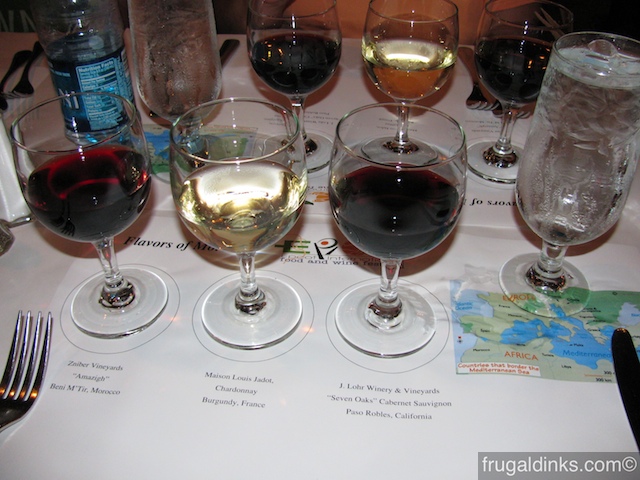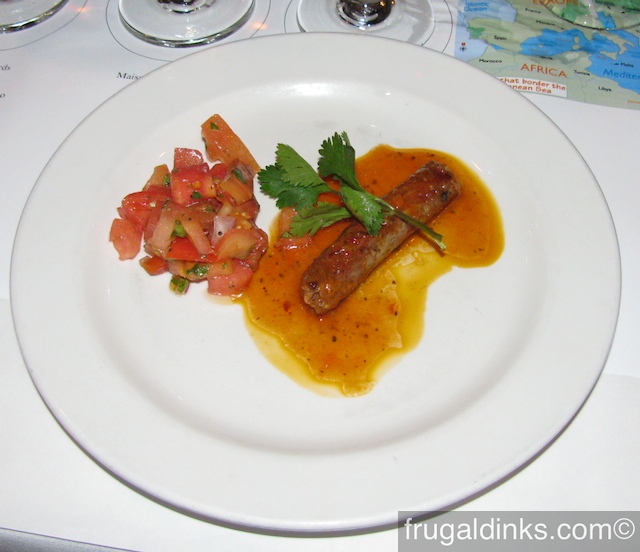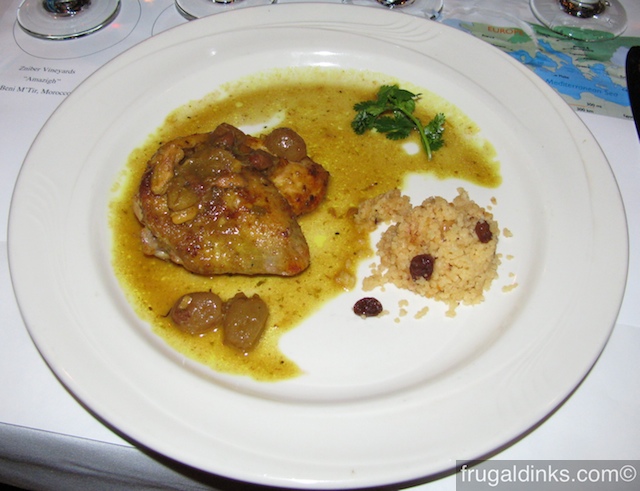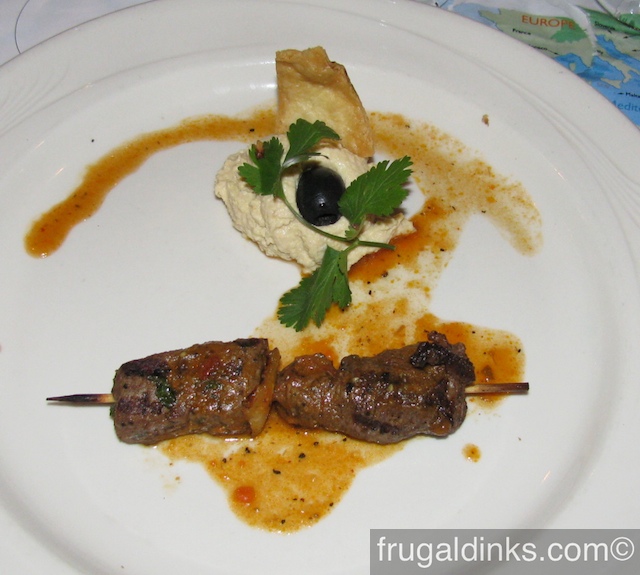Flavors of Morocco
The Chef at Restaurant Marrekesh (for 23 years) began the presentation by coming out and telling us about Moroccan Cuisine…

- Moroccan Cuisine
- now very popular around the world
- very diverse because of the numerous cultural influences
- Berber
- Spanish
- Corsican
- Portuguese
- Moorish & Arabic Andalsian
- Middle Eastern
- Mediterranean
- African
- not very spicy – as in “hot” spicy
- spices used in Moroccan food are very colorful
- national dish of Morocco is couscous
- comes from the original settlers, the Berbers
- very tiny grains

First Pairing

- Beef & Lamb Merguez
- came to Morocco by way of Jews leaving Andulusia
- black pepper
- texture and “chew” similar to North Carolina dried sausage
- texture similar to a good, non-fatty pepperoni
- Zniber Vineyards “Amazigh” Beni M’Tir, Morocco
- Zniber is a family name
- Amazigh is the wine name
- Beni M’Tir is a region of Morocco
- in the Atlas Mountains
- created by carbonic maceration
- each grape is fermented separately
- instead of crushing or pressing the grapes, they’re all put into a large vessel, as the naturally occuring yeast starts to consume the sugars inside each grape CO2 builds up in the grape causing the skins to pop; the juices run free and the resulting wine avoids the bitterness from grape seeds and skins
- fruit flavors in the wine were very quiet until tasting with food
- nice acidity
- Nick – not that pleasing, didn’t finish my glass
- Nora – okay, but seemed a bit chalky to me
Second Pairing

- Lemon Chicken with Couscous
- chicken was dry and overcooked
- couscous wasn’t very flavorful
- sauce was okay
- Maison Louis Jadot – Chardonnay; Burgandy, France
- french oak instead of american oak
- tight grain, flavors aren’t as “oaky” as american wines
- oak barrels are charred
- acidity of this wine “washes the palate”
- Nick: it was okay, didn’t finish my glass
- Nora: I like it better with food, the food flavors remove some of the oak and acidity
- french oak instead of american oak
Third Pairing

- Shish Kebab with Hummus
- came to Morocco by way of Arab immigrants
- plate was cold, not cool, not room temperature, but cold
- beef shish kebab wasn’t over cooked, medium rare
- best flavors overall
- hummus was good, very “creamy” – perhaps the olive oil is added in a stream after the chickpeas have been well processed, causing the oils to emulsify
- J. Lohr Winery & Vineyards – “Seven Oaks” Cabernet Sauvignon; Paso Robles, California
- raisin grape region/area
- all of the grapes for this cabernet sauvignon are estate grown
- Nick: this was the best of the three, I drank the entire glass
- Nora: I still like Cabernet Sauvignon, it’s been my favorite red wine for nearly 20 years
Final Thoughts, including past experiences at Resturant Marrakesh
- We had wanted to try this food & wine pairing because we’ve really enjoyed the food at Tangerine Cafe over the years (2002 to 2009), we’re only eaten there once in 2010
- We were hoping that because this was a special event that the food at Resturant Marrakesh would be better – the other three times we’ve eaten here have just been “not so good” to “downright horrid”
- We hear others say good things about the food here on the internet and on various podcasts
- We just don’t see why RM would be popular
- It’s not a matter of disliking the spices or grains or meats or vegetables
- It’s a matter of poor cooking or poor resturant management
- plates or platters that are cold (I mean the actual dishware, not the food specifically)
- vegetables that are CLEARLY overcooked
- meats that are reheated (maybe) and are dry
- staff attitudes have always been a bit iffy as if they don’t reallly care if guests enjoy their cuisine – however, this is also true at times in Tangerine Cafe
- It’s clearly puzzling how the food at the counter-service venue (Tangerine Cafe) can be so tasty and the food at the table-service venue (Resturant Marrakesh) can be so insipid and offputting
You must be logged in to post a comment.